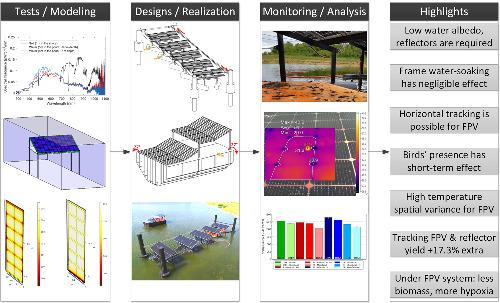当前位置:
X-MOL 学术
›
Prog. Photovoltaics
›
论文详情
Our official English website, www.x-mol.net, welcomes your
feedback! (Note: you will need to create a separate account there.)
Innovative floating bifacial photovoltaic solutions for inland water areas
Progress in Photovoltaics ( IF 8.0 ) Pub Date : 2020-12-03 , DOI: 10.1002/pip.3367 Hesan Ziar 1 , Bjorn Prudon 2 , Fen‐Yu (Vicky) Lin 3 , Bart Roeffen 3 , Dennis Heijkoop 4 , Tim Stark 1 , Sven Teurlincx 5 , Lisette Senerpont Domis 5, 6 , Elias Garcia Goma 1 , Julen Garro Extebarria 1 , Ignacio Narvaez Alavez 1 , Daniel Tilborg 4 , Hein Laar 4 , Rudi Santbergen 1 , Olindo Isabella 1
Progress in Photovoltaics ( IF 8.0 ) Pub Date : 2020-12-03 , DOI: 10.1002/pip.3367 Hesan Ziar 1 , Bjorn Prudon 2 , Fen‐Yu (Vicky) Lin 3 , Bart Roeffen 3 , Dennis Heijkoop 4 , Tim Stark 1 , Sven Teurlincx 5 , Lisette Senerpont Domis 5, 6 , Elias Garcia Goma 1 , Julen Garro Extebarria 1 , Ignacio Narvaez Alavez 1 , Daniel Tilborg 4 , Hein Laar 4 , Rudi Santbergen 1 , Olindo Isabella 1
Affiliation

|
Photovoltaic (PV) technology has the potential to be integrated on many surfaces in various environments, even on water. Modeling, design, and realization of a floating PV system have more challenges than conventional rooftop or freestanding PV system. In this work, we introduce two innovative concepts for floating bifacial PV systems, describing their modeling, design, and performance monitoring. The developed concepts are retractable and enable maximum energy production through tracking the Sun. Various floating PV systems (monofacial, bifacial with and without reflectors) with different tilts and tracking capabilities are installed on a Dutch pond and are being monitored. Results of the thermal study showed that partially soaking the frame of PV modules into water does not bring a considerable additional yield (+0.17%) and revealed that floating PV modules experience higher temperature special variance compared with land-based systems. Observations showed that the birds' presence has a severe effect on floating PV performance in the short term. Electrical yield investigation concluded that due to low albedo of inland water areas (~6.5%), bifacial PV systems must have reflectors. One-year monitoring showed that a bifacial PV system with reflector and horizontal tracking delivers ~17.3% more specific yield (up to 29% in a clear-sky month) compared with a monofacial PV system installed on land. Ecological monitoring showed no discernable impacts on the water quality in weekly samplings but did show significant impacts on the aquatic plant biomass and periods of low oxygen concentrations.
中文翻译:

内陆水域创新漂浮式双面光伏解决方案
光伏 (PV) 技术有可能被集成到各种环境中的许多表面上,甚至在水面上。浮动光伏系统的建模、设计和实现比传统的屋顶或独立式光伏系统面临更多挑战。在这项工作中,我们介绍了浮动双面光伏系统的两个创新概念,描述了它们的建模、设计和性能监控。开发的概念是可伸缩的,并通过跟踪太阳实现最大的能量生产。具有不同倾斜度和跟踪能力的各种浮动光伏系统(单面、带和不带反射器的双面)安装在荷兰池塘上并受到监控。热研究结果表明,将光伏组件的框架部分浸入水中不会带来可观的额外产量(+0. 17%) 并揭示与陆基系统相比,浮动光伏组件经历了更高的温度特殊变化。观察表明,鸟类的存在在短期内会对浮动光伏性能产生严重影响。发电量调查得出结论,由于内陆水域的低反照率(~6.5%),双面光伏系统必须有反射器。一年的监测表明,与安装在陆地上的单面光伏系统相比,具有反射器和水平跟踪功能的双面光伏系统可提供约 17.3% 的比产量(晴天月份高达 29%)。生态监测表明,每周采样对水质没有明显影响,但确实对水生植物生物量和低氧浓度时期产生了显着影响。
更新日期:2020-12-03
中文翻译:

内陆水域创新漂浮式双面光伏解决方案
光伏 (PV) 技术有可能被集成到各种环境中的许多表面上,甚至在水面上。浮动光伏系统的建模、设计和实现比传统的屋顶或独立式光伏系统面临更多挑战。在这项工作中,我们介绍了浮动双面光伏系统的两个创新概念,描述了它们的建模、设计和性能监控。开发的概念是可伸缩的,并通过跟踪太阳实现最大的能量生产。具有不同倾斜度和跟踪能力的各种浮动光伏系统(单面、带和不带反射器的双面)安装在荷兰池塘上并受到监控。热研究结果表明,将光伏组件的框架部分浸入水中不会带来可观的额外产量(+0. 17%) 并揭示与陆基系统相比,浮动光伏组件经历了更高的温度特殊变化。观察表明,鸟类的存在在短期内会对浮动光伏性能产生严重影响。发电量调查得出结论,由于内陆水域的低反照率(~6.5%),双面光伏系统必须有反射器。一年的监测表明,与安装在陆地上的单面光伏系统相比,具有反射器和水平跟踪功能的双面光伏系统可提供约 17.3% 的比产量(晴天月份高达 29%)。生态监测表明,每周采样对水质没有明显影响,但确实对水生植物生物量和低氧浓度时期产生了显着影响。











































 京公网安备 11010802027423号
京公网安备 11010802027423号